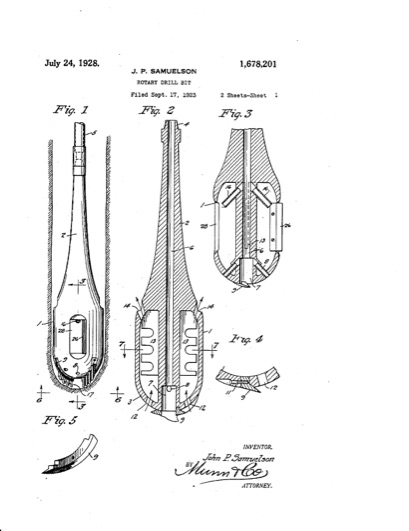
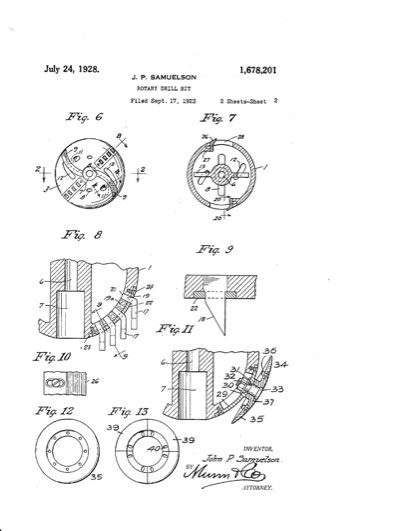
Endnotes
1 From the personal communication by John Samuelson, Los Angeles County Jail. January 6, 1943.
Reprinted with permission. The Harry Ransom Center, The University of Texas at Austin.
2 "Placer Mining Revival Noted." Los Angeles Times. Los Angeles, CA. December 26, 1927: p.16.
3 Samuelson, John P. Rotary Drill Bit. Patent 1,678,201. 24 July 1928.
4 Greene, Linda W. Historic Resource Study, A History of Land Use In Joshua Tree National Monument.
U.S. Department of the Interior, 1983: p. 263.
5 Samuelson, Johann. "Native Son of the Golden West." Word and lyrics. Unpublished. February 20, 1939.
Copyright #188497, entry number 7972: p. 328. Edom, California. Library of Congress, Copyright Office.
Catalog of Copyright Entries. Part 3, Musical Compositions. 1939. New Series, Volume 34, No. 1.
Washington, D.C.
6 Candelario, Frank SSGT. The Land Around Us, "Who was the bitter scribe of Quail Springs?" The Desert
Trail, November 4, 1964.
7 "One Man slain in Café Brawl." Los Angeles Times. Los Angeles, CA. December 24, 1942:
Part I.,p.13.
8 "Private Watchman Held in Death Case." Los Angeles Times. Los Angeles, CA. December 31,
1942: Part II., p. 16.
9 "Slaying, 1 dead, 1 Wounded in Yule Eve Row. "Los Angeles Evening Herald and
Express. Los Angeles, CA. Friday, December 25, 1942: p. A-6. Print.
10 "One Man slain in Café Brawl." Los Angeles Times. Los Angeles, CA. December 24, 1942: Part I.
p.13.
11 From the personal communication by John Samuelson, LA County jail, Undated 1943. Reprinted with
permission. The Harry Ransom Center The University of Texas at Austin.
12 ibid.
13 From the personal communication by John Samuelson, Los Angeles County jail, February 3, 1943. Reprinted with permission. The Harry Ransom Center, The University of Texas at Austin.
14 ibid.
15 ibid.
16 Los Angeles Superior Court. The People of The State of California v John Samuelson. Superior Court
County of Los Angeles. Complaint—Criminal, Felony, Charge, Murder & Assault with Intent to commit
Murder. Case #C-8992, December 29, 1942.
17 California State Archives, Inventory of the Department of Mental Hygiene – Mendocino State Hospital
Records. Patient Indexes 1893-1955: p.128-132.
18 From the personal communication by David B. Williams M.D. Superintendent, Mendocino State Hospital,
December 3, 1947. Reprinted with permission. The Harry Ransom Center, The University of Texas at
Austin.
19 California State Archives, Inventory of the Department of Mental Hygiene – Mendocino State Hospital
Records. Patient Indexes 1893-1955: p.128-132.
Illustrations
All photographs were taken by the author unless noted otherwise.
I. A view of the valley where Samuelson carved the granite outcroppings.
II. Samuelson's Rocks and former home.
III. Mojave Desert Cosos Range petroglyphs of bighorn sheep. China Lake Naval Weapons Station,
Ridgecrest, California.
IV. Old iron bed at the top of the rock outcropping where Samuelson built his first home.
V. Sentiments that reflect upon the Great Depression.
VI. Labor Crucified, S.P. Dinsmoor's Garden of Eden. Lucas, Kansas.
VII. The ROCK OF FAITH. The only rock signed by Samuelson.
VIII. MOTHER TIMECLOSE
IX. MOTHER TIME close-up showing layout lines for text.
X. RELIGION IS A CODE.
XI. RELIGION. As seen from below.
XII. THE MILK OF HUMAN KINDNESS.
XIII. Map of the Gold Coast Colony and Adjacent Territories. Scale not given. By John George Bartholomew.
Scottish Geographical Magazine. Edinburgh: Royal Scottish Geographical Society, Vol. XII, issue 1,1896:
p. 21. "Rain Magic." Erle Stanley Gardner. Argosy, All Story Weekly, October 20,1928: p. 580–603.
XIV. GOD MADE MAN.
XV. HENRY FORD
XVI. Rotary Drill Bit. Samuelson, John P., Patent 1,678,201. 24 July 1928. Print.
XVII. JUDGE LINDSEN.
XVIII. Mendocino State Hospital, photograph. Date unknown.
Acknowledgements
I personally wish to thank the following individuals for their invaluable help: My wife, Elaine, who has offered great advice and good editing. Melanie Spoo, Museum Curator of the Joshua Tree National Park, for her valuable assistance in locating and sharing the resources at the museum related to this fascinating story. Her enthusiasm and interest are greatly appreciated. Jullianne Ballou of the Harry Ransom Center at the University of Texas at Austin who took my requests related to Erle Stanley Gardner and provided me with a wealth of personal correspondence enabling a better understand to the relationship between him and John Samuelson. Jaime Taylor of the California Department of Beverage Control who did her best to uncover information from 1942. Heather Erhart of The Desert Trail who helped resurrect the second half of an article that contained more insight into Samuelson's life and relationships. And finally the California State Library in Sacramento.
© 2015-2017 Phil Pasquini all rights reserved worldwide. No portion of this article may be reproduced in any manner whatsoever without written permission, except for brief quotations embodied in critical articles or reviews.
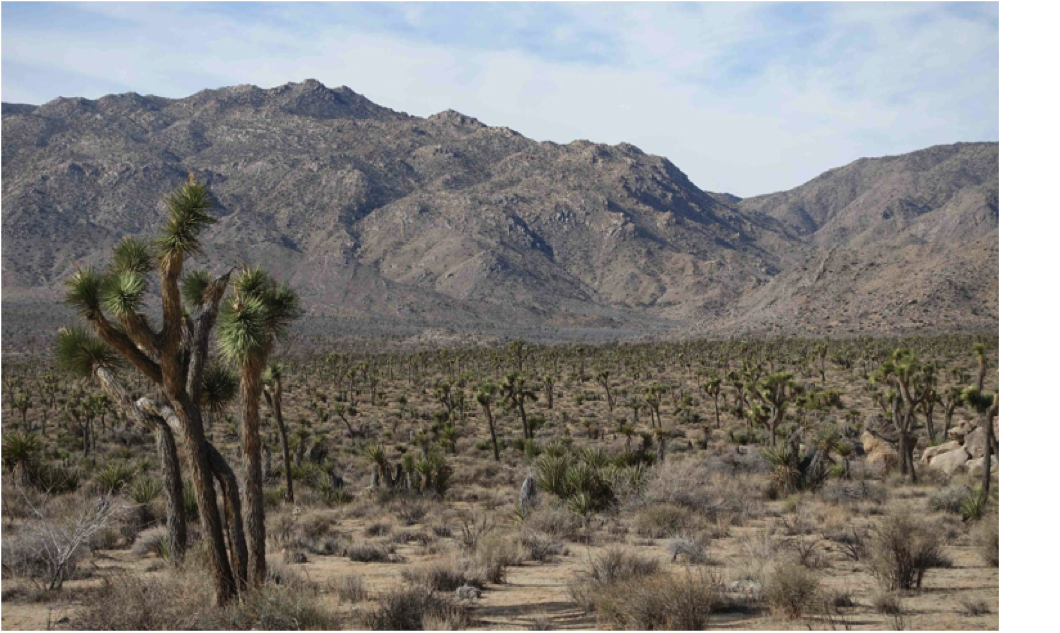
Samuelson’s Rocks
In the midst of an expansive sea of decomposed granite that makes up the Lost Horse Valley in today's Joshua Tree National Park is an island of weathered granite boulders part of a once unnamed and nondescript rock outcropping. It remained that way for eons until a man named John Samuelson arrived to homestead the area in the late 1920s. Inspired by religion, politics, nature and solitude, Samuelson set about to use the ancient rocks as a canvas to express his "eternal verities of existence," as he referred to them, along with his views on the Great Depression. His words are still quite visible today, looking much like they did when he carved them over 88 years ago.
II. Samuelson's Rocks and former home.
California’s harsh and arid Mojave Desert has long supported human life in a never-ending struggle where survival pits its inhabitants against the raw forces of nature. Today’s Joshua Tree National Park is just such a place where man has continued to exist in spite of its hostile and difficult climate. Over the millennia its inhabitants have on occasion recorded their passing permanently on its rocks and in its caves. Along with ancient petroglyphs and pictographs scattered across the region, there are more recent markings left by the pioneers who crossed the inhospitable desert and those of others drawn to the area for homesteading and seeking out its mineral riches. The need to embellish and leave one's mark behind has by no means been diminished by the passing of time. While these embellishments have been undertaken for various rationales, the engravings and paintings collectively have become a permanent record of human activity in the area. Perhaps the most prolific of these itinerate scribes was a Swedish immigrant named John Samuelson.
III. Mojave Desert Cosos Range petroglyphs of bighorn sheep. China Lake Naval Weapons Station, Ridgecrest, California.
Today, getting to the unique isolated folk art site involves a cross-country hike of several miles round trip in the Joshua Tree studded area of the hot, open, desolate and exposed desert, keeping casual visitors away. Visiting the site and seeing the rocks in person imparts great respect for how an independent and strong-willed person can triumph in even the most inhospitable of environments. Surprisingly, too, with a few exceptions, the rocks remain very much as Samuelson left them, exhibiting only minor changes of exfoliation.
IV. Old iron bed at the top of the rock outcropping where Samuelson built his first home.
Had fate not intervened and he not befriended by chance one day the lawyer and author Erle Stanley Gardner, later of Perry Mason fame, his story may have remained untold with the rocks becoming yet another of the desert's many mysteries. Samuelson's personal life, however, unlike his carvings, remains somewhat of an enigma. While Gardner recorded his first meetings with him and followed his story periodically over the years, an oft-repeated narrative has evolved around Samuelson's life and work, based partly on fact and in many instances misinformation and speculation, including dates and circumstances of important and pivotal events. But as with any narrative, once it is created and repeated, regardless of accuracy, it becomes the standard by which all else is known.
V. Sentiments that reflect upon the Great Depression which are much inline with S.P. Dinsmoor's Labor being crucified from The Garden of Eden in Lucas, Kansas.
John (Johann) P. Samuelson is reported to have first arrived in the Queen Valley area of California’s Mojave Desert in 1926 with his wife, Margaret, and shortly afterwards was hired by the well-known rancher and gold miner Bill Keys to work with him at his Hidden Gold Mine. Keys had earlier been involved with the flamboyant character Death Valley Scotty in a swindle that ended in the infamous "Battle of Wingate Pass." After working a year for Keys, the independent Samuelson quit his job, deciding instead to homestead and prospect for himself near Quail Springs in the nearby Lost Horse Valley. After selecting a site, he set about building a rickety shack, on top a granite outcropping where he later carved his proclamations. Below he built a corral that is still there today. Living in such a primitive and harsh environment meant that one had little time to pursue activities other than those it takes just to sustain life along with working a mining claim. Yet Samuelson somehow managed to use what free time he had to carve his rants in the stone faces of boulders near his encampment, inspiration for which came to him, he claimed through his communion with nature in the desert. He took great pride in knowing they would be there long after his death and for centuries thereafter.
His literary proclamations cover a wide range of subjects. Although the exact chronology of their carving is lost to time, he managed to impart his opinion and philosophical ideology for the world to take note of and to live by on only seven boulders over several years. The site's social criticisms are reminiscent, too, of S. P. Dinsmoor's Garden of Eden in Lucas, Kansas and in particular his Labor being crucified by Bankers, Preachers, Doctors and Lawyers.
VI. Labor Crucified. S.P. Dinsmoor's Garden of Eden. Lucas, Kansas.
Samuelson's poor command of the English language, grammar and rudimentary linguistic skills, combined with poor spelling and crude corrections, add greatly to the personality of his proclamations and impart a unique character to their presence. In many cases they have to be deciphered in order to grasp their message. Although he was said to have been embarrassed by his grammar and misspellings, he remained nonetheless proud of his efforts to inform and educate anyone who took the time to visit him at the site.
VII. The only rock signed by Samuelson.
The precisely carved words, all in caps, are incised deep enough into the desert varnish surfaces of the boulders to expose the underlying lighter colored stone, creating a high degree of contrast and readability. The layout of the words closely follow the contours and confines on the mostly flat planes of the rocks, indicating that he selected the stone surfaces carefully before he began his carving. His prodigious use of periods after words and question marks on the rocks is another unique characteristic of his proclamations and protestations. Misspellings abound along with his inventive corrections. An example of which is on THE ROCK Of FAIHT (faith) AND TRUHT (truth) where he also misspelled mankind as MANKINE. The misspelling is corrected by his over carving a D on the E, so the final result looks more like a flat B. Only this rock is signed and dated, John. Samuelson. 1927.
The largest carved proclamation is on a boulder perched high up on the jumbled granite rock outcropping that starts with MOTHER TIME. It is also the only stone that has engraved layout lines on the surface for the text. Six of his seven boulders each have a single proclamation while the seventh has two on adjoining right angle surfaces. One large split boulder has carvings on both of the former interior surfaces that now sit across from each other separated a few feet apart.
VIII.His comments on time and destiny.
IX. MOTHER TIME. Close-up showing layout lines for text.
As fascinating as these rocks are in their proclamations, isolation and difficult access, unraveling the story of Samuelson's life is even more captivating, mysterious and confusing. Although it is seldom attributed to him, Erle Stanley Gardner wrote the only documented references of the industrious Samuelson and his engraved rocks. Gardner, who was a frequent visitor to the Joshua Tree area with his "camp wagon" during the 1920s, related how he first became acquainted with Samuelson. Unfortunately, Gardner has written two different versions of this encounter separated by many years. The first in his book Neighborhood Frontiers, 1954, and the second as a preface to the chapter titled, Rain Maker, in the book, The Science Fiction Stories of Erle Stanley Gardner, The Human Zero, 1981. In the first he wrote that he met Samuelson who was accompanied by another man on February 9, 1928 and in the second version he used February 13th as the date and makes no mention of a second man. He also goes on to give two versions of how Samuelson began to relate his fantastic seafaring tale to him. In the first instance, he did so the day after they first met while in the camp wagon after they began drinking hot toddies and in the second version it was on the first day after they met when they sat down and began smoking. However, in his personal files on the meeting he used the February 13th date and sitting and smoking before he broached the subject about Samuelson having been a sailor. Since his earliest published recollection is the most complete, the story is as follows.
X. The boulder pinnacle at the top of which is the large engraving of RELIGION IS A CODE…
XI. The engraving that embodies religion and destiny.
While writing in his camp wagon on February 9, 1928 he heard a commotion and watched as two men arrived to collect water in a broken down car with a trailer holding a large barrel. He astutely observed the manner by which one of the men handled the ropes and hose and the lashing of the barrel and deduced the man had been a sailor. The next day the "sailor" returned and Gardner lent him a hand after the man explained he had car trouble and needed help to assist another man who was stranded. Gardner helped out by giving Samuelson a ride back to his homestead in his camp wagon where they were able to get the car started.

XII. Perhaps this comment relates to both President Hoover's humanitarian aid in feeding the Belgian people during WWI, through the Commission for the relief in Belgium (CRB) after the German invasion in 1914 and a criticism of his economic policies during the Great Depression. Hoover's Vice-President was Kansas Native-American Charles Curtis. Samuelson used the "?" often as an exclamation point.
Later that same day when the man returned for more water, Gardner invited him into the camp wagon for some hot tea and then offered him a hot toddy instead. As liquor usually does, one thing led to another and soon the two became engaged in a conversation when Gardner commented that he thought his guest had once been a sailor. After an initial shock, the man who introduced himself as John Samuelson soon began to talk about his exploits at sea. He related a most incredible and fantastic story of being drugged and Shanghaied in Cape Town followed by his escape from the ship by raft and a most bizarre tale ashore that included being taken captive by the natives on the coast of Ghana, two of whom spoke English, a monkey man, giant two-inch ants who guarded a ledge of gold and a princess to whom he was enslaved and fell in love with. And, finally, when he was banished from the tribe he and the princess were forced to eat the "Bread of Forgetfulness," or king-kee as the natives called it in the Fanti language, under penalty of death if he abstained. Upon eating the bread, he immediately blacked out only to regain consciousness later when he found himself in the company of white men along the coast in the settlement of Cape Coast Castle. Samuelson, who had no recollection of what had happened to him, was pronounced by them to be suffering from sleeping sickness.
Eventually Samuelson returned to civilization after he was put aboard a vessel headed to Boston where a doctor who was studying sleeping sickness would examine him. The doctor determined that Samuelson only suffered recurrent episodes of blacking out after heavy rains when the air was laden with the smell of damp green vegetation. Thusly, the doctor concluded that Samuelson was a victim of post-hypnotic suggestion and recommended that he move to a warm dry desert climate where it seldom rains to fully recover. This was how he ended up in the desert living the life of a prospector. As to the reversal of his memory loss, he explained that during the days-long black out spells he endured with the infrequent desert rains he began to experience horrific dreams. He eventually understood the dreams were memories of what had happened to him.
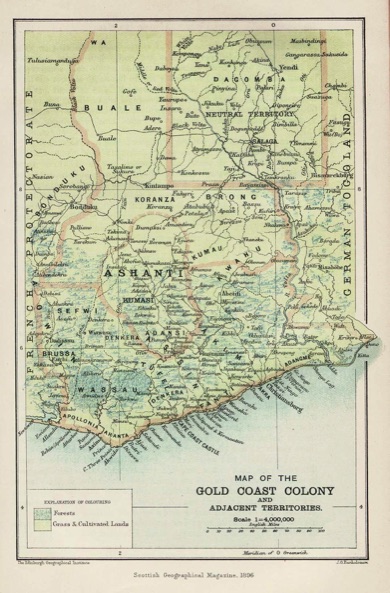
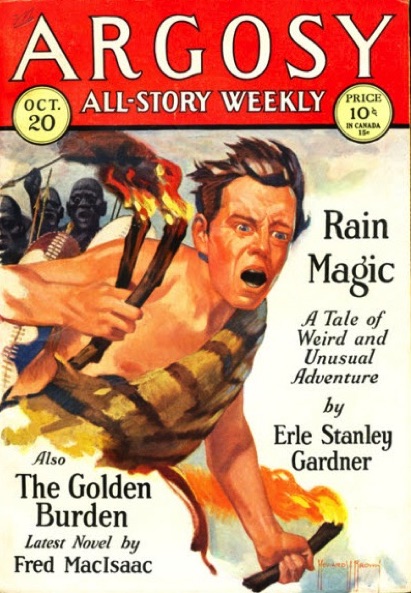
XIII. Map of Africa showing Gold Coast Colony and Cape Coast Castle. Royal Scottish Geographical Society1896. Cover of Argosy magazine, October 20, 1938 with the Rain Magic illustration.
At this juncture Gardner thought him to be a big liar and one of the greatest actors he had ever met. But he was so overwhelmed by the tale he had been told, that he decided to offer him twenty dollars or one-third of what he would make on selling the tale if it was published. Samuelson decided to take the cash. Ever the crafty lawyer, Gardner drew up a contract allowing him the exclusive use of the story, acknowledging payment and assigning all of the rights to him.
The next day a friendlier Samuelson returned and asked if Gardner would like to see his carved Rock of Faith. He confessed that in spite of his lack of a formal education and bad spelling, he was proud to produce his "eternal verities of existence" that had come to him in the desert for all mankind to observe. A few days after the visit Gardner packed up and headed "back to civilization."
Gardner was able to sell the story, Rain Magic, to Argosy magazine for $250 for publication in the October 20, 1928 issue and considered the well-received article an important milestone in his career. He sent a copy of the magazine to Samuelson but was unable to return to Quail Springs for several months. When he did return in early 1929, Samuelson seemed somewhat distant at first, but then offered to show Gardner his latest rock carving, GOD MADE MAN…. In typical Samuelson fashion it, too, had grammatical and spelling errors. In particular is the inventive superscript correction to the misspelled name of HENRY FORD. While apologizing for his grammar to a man of letters, he remained staunchly proud of his efforts. This was the last time the two men would ever see each other as fate had other plans that would change their destinies. Later that year, Samuelson's house was burned down while he was away. The fire destroyed everything he and his wife had and in letter he wrote while in jail to Gardner in 1943 he commented that "Bill Keys did it."1 In any case, the "desert eviction" did not deter him in his quest to strike it rich.
XIV. Samuelson's take on Henry Ford (1928) whom he both admired and trusted.
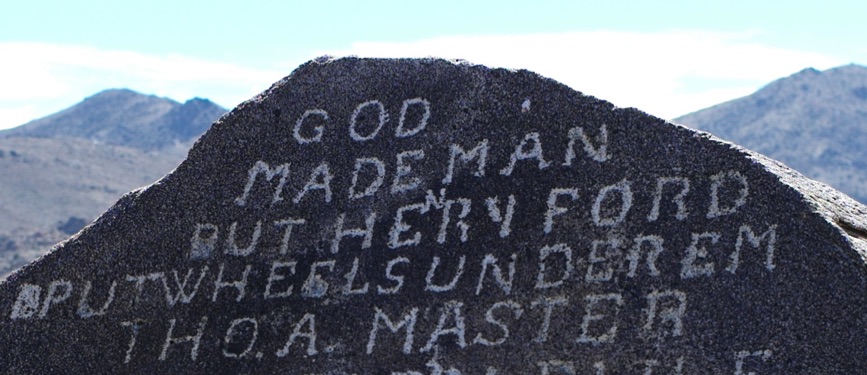
XV. Close up showing HE NRY FORD with corrections.
Who he was and where he came from can only be traced as far back as the Salt Lake City Directory of 1917, where an unmarried John Samuelson is working as a miner. Then, the 1920 U.S. Census for Salt Lake City shows him married to Margaret and employed as a carpenter in a mine and she as a cook in a bakery. Sometime after the 1920 census, the Samuelsons made their way to Compton California where they are listed in the city directory for 1922 as owning a home at 736 W Maple Street and John again lists his occupation as a miner while Margaret's employment is not shown. In 1925 they moved into a home at 636 W Maple Street that they would occupy off and on for the next 28 years. John listed his occupation at that time as an oil worker. But being a miner at heart, he left Compton for Twenty-Nine Palms in 1926 where he hoped to strike it rich. A year after working as a miner for Bill Keys, he quit and began homesteading and working his own gold mining claim. By December of 1927 the Los Angeles Times reported in a short article that John Samuelson had revived placer mining in the Quail Springs basin, and as a result cleaned up more than $2,000 worth of gold in three months during the summer.2
Not much else is known about his life there until the most unfortunate part of his story begins soon after the last time he saw Gardner in early 1929. Having applied for title to his homestead he was turned down due to his still being a Swedish citizen. Why his wife, a U. S. citizen, did not apply for the title as other women had done, remains a mystery. Completely crushed by this unfortunate turn of events, he continued mining his claim alone in the high desert, as the 1930 U.S. Census shows him at age 56 living in the Twenty-Nine Palms Township where he listed his occupation as a miner. Margaret, who by now may have had enough of the primitive lifestyle of a gold miner's wife at age 60, returned from the high desert where she found work as a domestic cook for a family in Los Angeles. But the old miner never gave up on his gold fever and in 1933 he continued his explorations with two partners filing a Notice of Location for a new quartz mining adventure in the Pinion (sp) Mining District. Nothing further is known about this mine and in 1934 he and Margaret took over the Hidden Gold Mine operation from Bill Keys and began working it. In July of 1935 Samuelson obtained a patent for his Rotary Drill Bit improvement for oil wells that he had invented in 1923 when working in the oil fields while living in Compton.3 In 1939 he reports to the Bureau of Mines to have completed over 700 feet of tunnel work.4 That same year, the miner — who was musically inclined—received a copyright for his original song and lyrics, "Native Son of the Golden West," while he was living in Edom, California.5 By the 1940 census, the then 70 year-old Margaret is again shown living alone in Compton.
XVI. Samuelson's improved Rotary Drill Bit. Patent issued July 24, 1928. Sheets 1 and 2.
XVII. His comments regarding the progressive jurist and social reformer who helped establish the juvenile court system, the abolishment of child labor and co-authored in 1927 the controversial book "Companionate Marriage."
In 1942 with his mining days behind him, the couple is once again living together in Compton when their lives tragically emerged from the shadows of the big city. By then he was employed as a night watchman for a local construction company owned by a man named Gregory. While on duty, he carried an unlicensed gun for personal protection, a practice no doubt adopted from his days of living in the remote desert. This was to be a dangerous mix for a man described by his wife, as a bitter and peculiar person all his life who would shoot a man for little or no reason.6
Unfortunately, the hard working, hard drinking 68 year-old, who stood five-foot eight inches tall and weighted 160 pounds, got into an argument on Christmas Eve with two drinking partners in a Compton Café/Tavern at 911 N. Wilmington Blvd a couple of blocks from his house.7 According to newspaper reports at the time, the argument began when Samuelson threw a glass of beer at a barmaid and was thrown out of the tavern by Anton "Tony" Gassman and Cecil Wright. Samuleson then went home to retrieve a pistol, returned to the tavern and shoot Gassman through the heart, killing the 45 year-old, former Graham County Kansas native and divorced father of five, and wounding 23 year-old Cecil Bennett Wright in the arm.8, 9 Arrested at the scene by Compton Police Captain Ray Hecock, Samuelson was jailed without bail.10
A Coroners Jury on December 30, 1942 recommended he be held on suspicion of murder charges and an arraignment was set for February 1, 1943. While being held in jail, Samuelson responded to a letter from Gardner in answer to an earlier letter he sent to him, wherein he explained that he was in "…a saloone (sp) fight with 4 pimps against a old Swede?"11 He went on to explain that, "… my wife Mage has gone back on me?"12 Possibly, his statement meant that she had abandoned him. In a letter dated on Feb. 3, 1943 he told Gardner,"… the mine is not for sale, as it took me eight years to make it and will be a meal ticket for the wife."13 He did offer to sell Gardner his house located a half-mile from the mine which he described as,
"… a nice place for a hide-out,"14 for $800 in order to raise money to pay his attorney, J.W. Pierce. Samuelson closed his letter by saying, "Don't feel sorry for me as I have lived mine and can take it. We from the open range do not die cowards."15 Gardner, who was by now a successful writer, was unable to respond to Samuelson's request, as he had to leave to attend a conference in New York. He did however, answer a letter from Samuelson's attorney's informing him that he was unable to offer any financial assistance.
Being unable to pay for private counsel, Samuelson was appointed the well-known Public Defender, Ellery E. Cuff, who later would defend the infamous murderess Louise Peete, the "Tiger Lady." Ironically, too, Judge Harold B. Landreth, who presided over Samuelson's hearings, was also the same judge who sentenced the convicted murderess to death. She was the second woman in California history to be executed, with her sentence carried out in San Quentin's gas chamber in 1947.
At his third court apperance on February 8, 1943, Samuelson pleaded not guilty by reason of insanity. The court then appointed three psychiatrists to examine him and to report their findings at a hearing set for March 22nd. One of the doctors, Karl O. Von Hagen, was married to the actress, Vivian Tobin, who had played Alice in America's first production of Alice in Wonderland in 1915 at the age of 11. When Dr. Tobin and his colleagues presented their findings to the court on March 22nd, Samuelson was declared to be
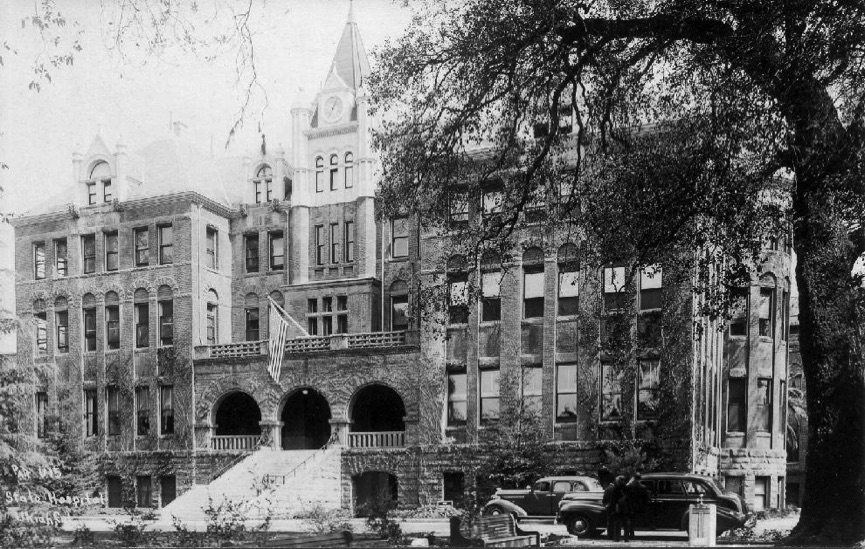
XVIII. Mendocino State Hospital, Talmage, California. Samuelson former home.
insane. Court documents stated that, "Court finds deft (defendant) presently insane – Committed to the Mendocino State Hospital and to be returned to this court when his sanity has been restored."16 He was admitted to the Mendocino State Hospital on April 8, 1943 as patient number 19733 12.17 He soon settled into the daily routines of the institution working in the mattress and upholstery shop, thusly, escaping the death penalty.
Gardner heard nothing further from or about Samuelson for several years until he began working on his series, The Court of Last Resort, for Argosy magazine and had occasion to return to Quail Springs to investigate a murder. While in the area, he decided to try and locate Samuelson's old homestead. After searching about, he discovered that the former home had been burned to the ground and that only the rocks with their proclamations, remained along with a few embers. As he walked around the granite-strewn hill he discovered a new carving, Wake Up You Tax and Bond Slaves…, that he had not seen before. The visit renewed his interest in trying to find out what ever happed to Samuelson. He began by contacting the court and learned of Samuelson being declared insane and committed to the Mendocino State Hospital. Gardner then concluded that the old desert prospector had used his survival instincts to beat the rap. Afterwards he wrote to the hospital inquiring of Samuelson's status.
In response to his inquiry, Gardner received a letter from the superintendent and Medical Director, Dr. David B. Williams MD dated December 3, 1947, in which he learned Samuelson had been a well-adjusted inmate apparently fitting into his new life at the hospital without any problems. After three years in the institution, however, it seems the 72 year-old Samuelson had had enough and Gardner learned that on "July 1, 1946, the patient ran away from the hospital, and no word has been heard from him or about him by anyone up to this time. He did not go home, and he did not contact his wife; and nothing is known as to his whereabouts."18 The clever Samuelson simply vanished and was never to be heard from again.
Whatever happened to Samuelson after his escape, other than the often-repeated narrative of his death in 1954 at age 83 in a lumber camp in Washington state, may never be known other than he had successfully managed to elude the consequences of his actions. Or did he? His hospital admission entry has three notations made later under the column REMARKS next to his name. The entries indicate his escape, "E 07/1/46" in dark grey, overwritten with a notation in black ink, "Transf. to Atascadero St. Hosp. 4/1/55" and the cryptic numbers and letters "1368 pc" written in red ink.19 Or could he have been recaptured at some point and sent back to the facility?
Since California state hospital patient records are sealed for 75 years due to confidentiality, we may not know until some time in the future what actually happened to him. Gardner, on the other hand, speculated as to Samuelson's later years and fate in his book, Neighborhood Frontiers, when he opined that perhaps the old prospector and a princess were enjoying the later years of their lives somewhere in Africa.
As Samuelson well knew when he first carved his rocks, he would live on in spirit through the ages by recording his "eternal verities of existence." Leaving behind his petro-prophetic messages follows in the great tradition of desert dwellers the world over from time immemorial. And while the meanings of both petroglyphs and pictographs are often speculative, Samuelson's rocks are clear in both their intent and meaning, leaving no doubt in their contemporary viewers' minds as to the universal messages they contain. Perhaps future archaeologists will wonder who undertook these works, their meanings and why they were carved, but for the time being they continue to add greatly to their environment for passersby to think about and enjoy in their lonely and isolated high desert domain.
ARE YOU THE FELLOW
MRMELLON THAT GRABEDALL OUR DOUGH. AINT YOU BETTER UP AND TELL US. WHERE IN HELL DID IT GO.
This is his take on the Secretary of the Treasury, Andrew Mellon (1921-1932), the wealthy industrialist and banker and America's third largest taxpayer. Mellon believed in what he called, "Scientific Taxation" known as The Mellon Plan, that was the basis for his idea of trickle down economics, by affording the rich large tax cuts.
Petro-Prophetic Words Hewn In Stone